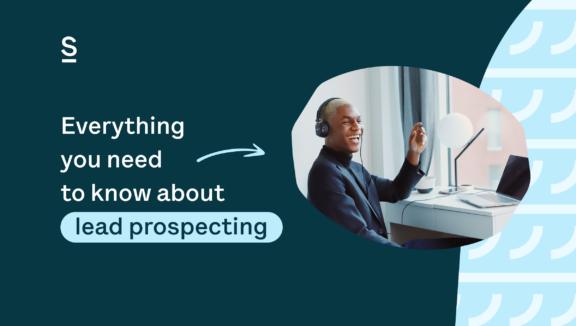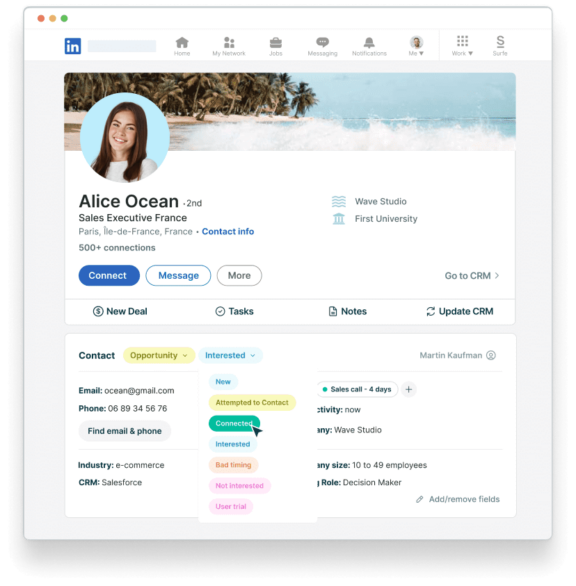Everything you need to know about lead prospecting

If you’ve ever asked yourself “What is the difference between a lead and a prospect?” – this one’s for you.
Sales success happens when you find the right customers. Without customers, no one will buy what you’re selling. And any old customers won’t work – it has to be the right ones, hand-selected and curated because they’re a perfect fit for your product. But how do you find the ideal customers? It all starts with lead prospecting.
Read on to find out everything you need to know about lead prospecting, lead generation, and marketing to ensure you’re finding the right people that will soon become customers, eventually leading you to sales success.
What is lead prospecting?
Lead prospecting is searching for and gathering people that might one day be customers. The definition of prospecting is the process of finding quality leads. People go from leads to prospects to customers as you funnel them down the sales pipeline. The first step to lead prospecting is identifying people that could potentially become prospects and, hopefully, future customers.
The difference between a lead and a prospect
A lead is just the beginning – an unqualified person that may or may not be the right fit for your business. A prospect is a qualified lead, someone that has been moved into the first stages of the sales funnel.
Oftentimes, the difference between a lead and a prospect is related to communication. With a lead, there’s often one-way communication where you’ve contacted someone that could be a possible fit. Once they respond and your communication goes both ways, this could be the moment they move from being a lead to a prospect. Once it’s clear a lead has the potential to become a customer, they become a prospect.
When it comes to lead generation vs. lead prospecting, lead generation is usually about gathering a bunch of possible clients by way of marketing, while prospecting is more individual. Lead prospecting is where sales reps reach out to leads they truly feel could be qualified in a more personal way.
How to turn a lead into a prospect
Turning a lead into a prospect is a key aspect of the selling process and sales pipeline. The first step is to qualify your lead, which you can do by seeing if they fit the following:
- Does your lead need a product or service that you can provide?
- Does your lead have a problem or pain point you can solve?
- Does your lead have the ability to pay for your product or service?
Once you understand if a lead can indeed become a quality prospect, the next step is to make them one. Make sure to make them feel singled out and important, using information and dedicated research to best appeal to them about how your product is a good fit. Don’t treat them like one of the masses – this is where a personal connection goes a long way.
Make sure to use a CRM to track their progress along the sales funnel and that your entire team knows where things stand so other reps or teammates aren’t contacting them with repeat information. Once you’ve formed a solid relationship with your prospect, there’s a higher chance they’ll become a customer.

Add prospects to your CRM directly from LinkedIn
Surfe brings your CRM to LinkedIn, showing your contact data on top of LinkedIn profiles and allowing you to add new prospects to your CRM from LinkedIn in one click.
Don’t forget about social selling tactics
Social sellers outsell those that don’t use social media by a whopping 78%, according to data from LinkedIn. Remember, when it comes to B2B, sales are often gradual, built through a long-term relationship commitment, so don’t panic if a sale doesn’t happen overnight.
So, use social selling tactics, like building rapport with your virtual followers and friends in a respectful way that will encourage healthy business relationships and help leads become prospects naturally (yes – natural these days often means communication and relationships formed on the internet).
Social selling can help establish your brand, connect you with qualified leads (which makes it easier to turn a lead into a prospect), and build better professional relationships that can slowly grow into successful deals. It can also increase your chances of inbound prospecting – meaning your brand is so credible that potential leads are reaching out to you with questions and inquiries, not the other way around.
When it comes to social selling, platforms like Twitter and Instagram can be useful, but utilizing LinkedIn to your benefit – establishing credibility, connecting with peers, and growing your network – is probably the most useful social media platform when it comes to forming successful sales deals down the line.
These are the best lead generation strategies
Having a strategy (or a few) for lead generation is the best way to find qualified leads that turn into prospects. Start by creating ‘opt-in’ opportunities to get possible leads onboard and interested in what you have to offer.
At this stage, it may be best to consider content distribution and ABM (account-based marketing), which are easier to automate. Once a lead is a prospect, more personal connections become the key to sales success.
Think about things like newsletters, marketing, direct, and sales outreach emails, and paid ads. All of these are ways to generate interest in your brand and make it easy for you to start connecting further with interested parties. This type of marketing is easy to automate, and users have a choice to opt-in or opt-out, thanks to EU GDPR policies (which of course, you should be following). Just remember not to overdo it – you should really only be sending one marketing email per week.
Can’t find your leads’ email addresses? Surfe can help when it comes to lead generation. We’ve partnered with Dropcontact to ensure your email marketing is both GDPR-compliant and effective.
These are the best lead prospecting strategies
Sales reps take note: Prospecting should be more personalized and less automated in order to attract quality prospects. Once a lead is qualified and therefore becomes a prospect, it’s time to start contacting these prospects personally, one by one.
Creating points of connection and a professional relationship with a qualified lead or prospect ensures you’ll have further points of contact with them, which is important when funneling them down the sales pipeline.
Personally tailored pitches, emails, demos, and even phone calls that speak specifically to a prospect’s needs, can turn a prospect into a client. Think about the problem your prospect is having – how can you solve it?
This process takes time, but it can pay off, assuming you’ve done your research and properly qualified your lead. Although automation can be helpful initially, this stage is all about personalization. Don’t forget to consider using a marketing funnel, which, in addition to a sales funnel, can help you visualize exactly how your prospecting and marketing efforts can guide and further the sales process. To gain deeper insights in your marketing funnel optimization, consider following a comprehensive marketing funnel analysis guide. This will help you identify bottlenecks, measure conversion rates, and make data-driven decisions to improve your overall marketing strategy.
How Surfe can help with lead generation and lead prospecting
We previously mentioned that Surfe’s partnership with Dropcontact can be useful for lead generation, but it can assist with so much more than that.
Besides all of the time-saving value Surfe provides by helping to automate processes like building and exporting contact lists to the CRM at the lead generation stage, it can also assist with lead prospecting by sending outreach messages with personalized templates and keeping information and communication organized and updated, including your lead, prospect or customer’s status.

This helps free up your time, allowing you to focus on adding that personal touch to the lead prospecting and sales trends we detailed out above.
Have you enjoyed reading this article? We think you might also like the ones related to…
Also, if you have not done it yet, do not hesitate to take a look to our CRM-related pages:

Connect your CRM to LinkedIn in 60 seconds
Over 80% of B2B leads come from LinkedIn, but it’s not optimized for sales. Surfe seamlessly integrates your CRM with LinkedIn for easier prospecting, contact entry, and deal management.


